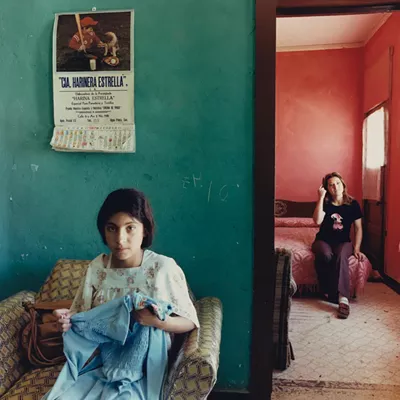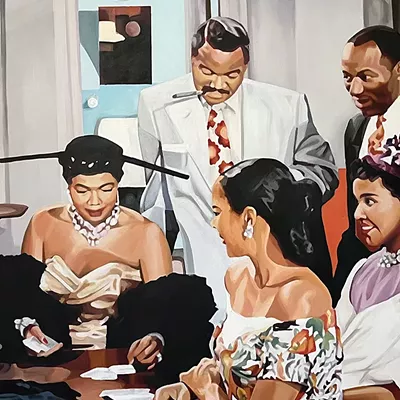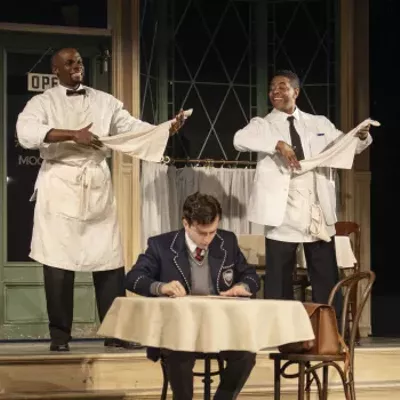Tucson augured better. Florencio Limón was hired on as conductor of the band and orchestra run by the Southern Pacific Railroad. He enrolled his 7-year-old son, José, in one of the city's convent schools.
"My teacher was Sister Cornelia, a nice elderly woman," José Limón would remember years later, when he was a world-famous figure of modern dance. "I didn't know one word of English," but after some initial teasing, he found "the gringos were not as bad as I had been led to believe. Little by little I began to understand what it was all about," he told writer Barbara Pollack in 1955.
Understanding what it was all about is an understatement. The Limóns soon moved to California, and after first training as a painter in Los Angeles and then New York, José Limón went on to a stellar career in the new art form of modern dance. He danced with such pioneers as Charles Weidman and Doris Humphries, and developed a muscular style of dance that celebrated the male. His own groundbreaking choreography, some of it on Mexican themes, was known for its intense passion.
"For José, man is part angel, part devil and everything in between," says Carla Maxwell, who began dancing with Limón at age 19 in 1965. "He wanted to show the range of emotions."
Limón died in 1972, but the Limón Dance Company he founded in 1946 with Humphries has continued on, performing works both by its founder and other choreographers. On Wednesday, March 5, the troupe gives one performance only at Centennial Hall. (The dance week begins on Friday, Feb. 28, with a full slate of concerts by Tucson's own Orts Theatre of Dance. See below for details.)
"It's a very full program," says Maxwell, the Limón artistic director for the last 25 years; two of the concert's five dances are by Limón himself. Traveling backward in time, the show begins in silence with one the last works the choreographer made before his death, 1970's "The Unsung," and ends with a burst of choral music that accompanies a new production of 1967's "Psalm."
All seven men in the company dance "The Unsung" in silence.
"You won't miss the music," Maxwell says. What distinguishes Limón, she adds, is "the form of the work. It's very powerful. There's nothing extra. Everything is there for a reason."
The concert breaks historical ground, offering up a pared-down version of "Psalm," set to newly composed music.
"José was inspired by the book The Last of the Just by André Schwartz-Bart, about the Jewish legend of the 36 just men on whom all the sorrows of the world rest," Maxwell says. "He wanted to use music by Stravinsky but he couldn't afford it." Instead, Maxwell used music by a young composer whose fee he could pay, and produced a 50-minute dance that was "a magnificent work but (whose) overview was not as clear as it could have been." Maxwell produced an edited version in 1976, but several years ago she began a more comprehensive revamp.
"I reworked the piece and had a new score commissioned," she says. "I found choreographic notes of José's. He wanted it to be a choral work. Composer Jon Magnussen made a new version, with a full choir singing the Latin Vulgate, and 10 musicians. We did the premiere live at the Olympics last winter. It's very moving. I think we nailed it."
"Psalm," which will be danced in Tucson by the full company to recorded music, marked a dramatic change in the choreographer's style. Most of Limón's early company members had left by the mid '60s, and he turned toward greater abstraction.
"'Unsung' is the culmination of that style," Maxwell says. "Both of these works are very modern, and not dated. You're dancing about life. They're wonderful companions to each other."
In between the two historical works, the troupe undertakes three more recent pieces that "change your palate." The brand-new "Phantasy Quintet" premiered in San José in November; a work for seven dancers, it was choreographed by Adam Hougland, a former Limón dancer. "Oneero," a solo for Roxane D'Orléans Juste, is excerpted from "Heartbeats," a longer Donald McKayle piece from 1997. (McKayle, another leading modernist, serves as company "artistic mentor.")
"The Unsightful Nanny" is a "very fun piece" based on the Edward Gorey short story "The Gashlycrumb Tinies." It's peopled by nine macabre characters, from The Waif to The Wimp. Company member Jonathan Riedel composed the 1992 piece, and dances the part of The Nanny.
FOR ITS CONCERT Embracing the Moment, Orts Theatre of Dance returns to the Amazon with a reprise of "Mayatin," a video/dance/trapeze work inspired by the company's real-life adventures in the jungle. Premiered last November, the dance "ebbs and flows through different sections, all of them expressions of the rain forest: the rain itself, bugs, mud and pathways, mushrooms, butterflies, rivers and impending destruction," says Annie Bunker, choreographer and Orts artistic director.
Seven Orts dancers work the floor and fly through the air on the company's trademark trapezes, "shape shifting" from human to plant to animal, Bunker says. They interact with the jungle videos crafted by company technical director Chuck Koesters. Koesters also created the soundscape of music and forest noises, from birdcalls to bug buzzes to raindrop drips. The title "Mayatin," or breath, comes from the language of the Achuar people of Ecuadorian Amazon.
Three shorter works, all new to Orts, are also on the program. UA dance prof Susan Quinn contributed "St. Teresa," a work about an intense friendship among three women, danced by Bunker, Amy Knoke and Katie Rutterer. Another Bunker piece, the duet "Mercurial Origins," features an original score by Steve Roach, and dancing by Knoke and Rutterer. An old Tucson favorite, "Everlast," by Thom Lewis of FUNHOUSE Movement Theater, chronicles the tragicomic end of a relationship, which dissolves to the tunes of Lyle Lovett. Charles Thompson and Bunker put on the boxing gloves and dance the doomed couple.










